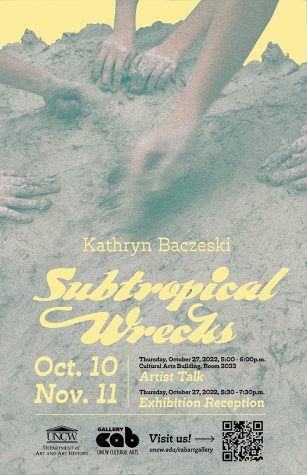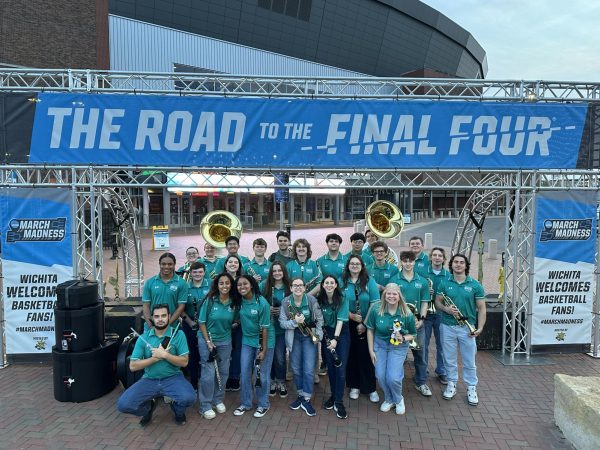Kathryn Baczeski challenges the meaning of art in ‘Subtropical Wrecks’
Is it that art is meant to last, or that art is meant to have a lasting impression? For Kathryn Baczeski, a visual artist, the latter is at the heart of her artist practice and is exemplified in her ephemeral installation, “Subtropical Wrecks,” now on view at the CAB Gallery until Nov. 11. On Oct. 27, a couple of weeks after the soft opening of the show, Baczeski hosted a public reception and Artist Talk where she discussed the evolution of her artistic practice. In this show, Baczeski transports the natural world into the gallery space using organic, locally sourced material.
Using organic matter local to North Carolina, such as clays, sands and pine needles, Baczeski constructed the pieces in the gallery space, leaving them subject to the influences of their environment. The pieces exist in a constant state of decomposition and rebirth as the pine needles and the sand shift and the clay cracks and falls off the walls.
“I think in this particular moment, 2022, I’m thinking about the way that earth is eroding and how our time is ephemeral and the land we inhabit is also ephemeral,” explained Baczeski.
Before the public reception for the show, Baczeski gave an Artist Talk where she presented the timeline of her artistic projects and exhibitions, as well as the evolution of her practices. She noted her love for clay because of its ability to capture an event in any form.
“It kind of highlights a moment,” said Baczeski. “It’s here, and then it slakes down and it’s gone, much like us as vessels and people.”
The idea of object evolution has been a common thread in Baczeski’s work over the years. As a ceramic and visual artist, she explores the ephemeral timeline of art objects.
“I think I’m trying to rebel against this art market world,” said Baczeski in her Artist Talk. “I hate the way objects are commodified, which is probably another reason why I’m making things have such a short life span in their physicality.”
Upon entering the gallery, the viewer is confronted by a gravity-defying mound of pine needles entitled “Are You My Mother?” Placed in the mound, at eyelevel with the viewer, is a TV screen playing one of Baczeski’s visual arts performances. The sounds of the video, of ocean waves and children playing, washes over the entire gallery to influence the feeling of the other pieces.
This sound particularly influences the interpretation of a piece entitled “All the Attempts.” Various objects made out of clay rest on a layer of sand spread across a pedestal display. Some of the clay objects are fired and glazed, having a more distinct sense of permanence, while others evoke dripping sandcastles that could easily be washed away by an incoming tide. The shapes of these castles, in addition to ceramic pinecones and abstracted leaves, look as if they are the remnants from a long day spent playing at the beach. The audio playing throughout the gallery enhances this feeling of a day well spent.

One piece, entitled “Erosion Wall – It’s All Here,” feels almost like a natural growth dripping from the gallery. Baczeski produced this piece by spreading layers of clay directly onto the surface of the wall. Like all the pieces in the show, this creates a beautiful contradiction of where the linear, man-made space meets the organic growth of the artwork.
The fourth and final piece in the show, “Earth Collaboration,” evokes this quality of growth, like a beautiful fungus. Sitting atop a nearby pedestal is a mound of gray clay with a broken ring of blue clay from which pieces of vegetation sprout. This artwork is so organic in composition that the human manipulation of the material could be easily missed if it were not in a gallery.
“I like when there’s a question or a possibility for a work to shift and morph,” said Baczeski. “Sometimes I don’t know what’s going to happen. I’m thinking about the gallery as the canvas or palette.”
When discussing her introduction to art, Baczeski mentioned the privilege of growing up in New England. “I also grew up in Connecticut, in close proximity to a lot of institutions like everything you found in New York City: MASS MoCa, the Guggenheim, the Wadsworth Museum in the capital of Connecticut,” she said. “This was a very privileged upbringing that I also wasn’t totally aware of until I kind of got out of Connecticut. So, it’s very important to kind of recognize where you are and what you are seeing when you’re there.”
She recently moved to Louisiana where she works as a ceramics professor. Moving to the deep South presented a new experience for Baczeski. Because her artistic practices are influenced by her surroundings, she is taking the time to investigate and absorb the landscape. This is an exciting time in her artistic career because the creations that come next are yet to be discovered.
Her exposure to the Art world influenced her love for the eccentric people subverting it, such as Andy Warhol or Bruce Nauman. Baczeski mentioned this notion of the Art world with a capital A in her presentation when referring to the fine arts. The fine arts are more rigidly restricted in their classification and are usually not as accessible to the everyday person. This, in turn, plays into the art market which influences the valuation and trends of popular art.
“I don’t love the way that a painting of Pollock is appreciating in value and it’s just a thing that can be passed around as a power painting, a status symbol,” said Baczeski. “I think art is really for everyone.” This subversion of the Art world is consistently visible in her work both in galleries and outdoors. “Subtropical Wrecks,” her first solo show in six years, challenges notions of what art in a gallery space looks like and who it’s for.
“Subtropical Wrecks” has an overall presence of positive ambiguity. The play of organic objects in a gallery space creates open-ended questions for each viewer to answer for themselves.
“I like that teasing out of what exactly is going on to keep the viewer in the space a little bit longer,” said Baczeski. “It’s too easy to come to something and say, like oh yeah, that’s a vase or a painting of X, Y, Z.”
The phrase “nothing good lasts forever” comes to mind when thinking of this show. After the closing of the show on Nov. 11, the pieces will be deconstructed, just as they were first created
in the space. The disassembly of the pieces will be their final decomposition, leaving the organic matter to be introduced into another cycle of creation. The gallery walls will be painted with a fresh coat of paint, ready for the exciting upcoming senior exhibit. And yet, the impression left by Baczeski’s work on the mind of every viewer will be a lasting one.







